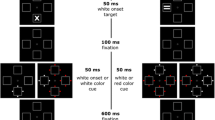Summary
Same-different reaction times (RTs) were obtained for pairs of color samples ranging perceptually from blue to green. In Experiment 1, observers responded with “same” if both stimuli in a pair were from the same hue category (i.e., blue-blue or green-green) or “different” if the two stimuli were from different hue categories (i.e., blue-green or green-blue). RT for “same” responses was faster for pairs of physically identical stimuli (A-A) than for pairs of physically different stimuli (A-a) belonging to the same hue. RT for “different” responses was faster for larger physical differences across a boundary between hues (A-B 6 step) than for smaller physical differences (A-B 2 step). Experiment 2 replicated and extended these findings: In one phase observers matched pairs of stimuli as “same” or “different” by categorical similarity as in Experiment 1, and in a second phase observers matched the same stimulus pairs, this time by physical similarity. Matching by categorical similarity replicated the pattern of results found in Experiment 1. Matching by physical similarity showed that RTs for “different” responses were equivalently fast independent of the physical difference between A-B pairs, but were faster for A-B than for A-a comparisons. Further, matching identity was faster under categorical match instructions than under physical match instructions. Results of the two experiments support a model of parallel processing of physical and categorical stimulus information in color perception. Further, these reaction-time data and their implications in color perception (for hues) parallel reaction-time data and their implications in speech perception (for phonemes).
Similar content being viewed by others
References
Beare, A.C. (1963). Color-name as a function of wave-length. American Journal of Psychology, 76, 248–256.
Bornstein, M.H. (1979). Perceptual development: Stability and change in feature perception. In: Bornstein M.H., Kessen W. (Eds.), Psychological Development from Infancy. Hillsdale, NJ: Erlbaum
Bornstein, M.H., & Korda, N.O. (1984). Some psychological parallels between categorization processes in vision and in audition. In: Harnad, S. (Ed.), Categorical Perception. New York: Cambridge University Press
Bornstein, M.H., & Monroe, M.D. (1980). Chromatic information processing: Rate depends on stimulus location in the category and psychological complexity. Psychological Research, 42, 213–225.
Boynton, R.M. (1979). Human Color Vision. New York: Holt, Rinehart, & Winston
Boynton, R.M., & Gordon, J. (1965). Bezold-Brücke hue shift measured by color-naming technique. Journal of the Optical Society of America, 55, 78–86.
Graham, C.H. (1965). Discriminations that depend on wavelength. In: Graham, C.H. (Ed.), Vision and Visual Perception. New York: Wiley.
Hanson, V.L. (1977). Within-category discriminations in speech perception. Perception & Psychophysics, 21, 423–430.
Howell, P., & Darwin, C.J. (1977). Some properties of auditory memory for rapid formant transitions. Memory & Cognition, 5, 700–708.
Ishihara, S. (1968). Test for Colour-Blindness. Tokyo: Shuppan
Pisoni, D.B., & Tash, J. (1974). Reaction times to comparisons within and across phonetic categories. Perception & Psychophysics, 15, 285–290.
Posner, M.I. (1969). Abstraction and the process of recognition. In: Bower, G.H., Spence, J.T. (Eds.), The Psychology of Learning and Motivation (Vol. 3). New York: Academic Press
Posner, M.I., & Mitchell, R.F. (1967). Chronometric analysis of classification. Psychological Review, 71, 392–409.
Raskin, L.A., Maital, S., & Bornstein, M.H. (1983). Perceptual categorization of color: A life-span study. Psychological Research, 45, 135–145.
Studdert-Kennedy, M., Liberman, A.M., & Stevens, K.N. (1963). Reaction time to synthetic stop consonants and vowels at phoneme centers and at phoneme boundaries. Journal of the Acoustical Society of America, 25, 1900.
Wood, C.C. (1974). Parallel processing of auditory and phonetic information in speech perception. Perception & Psychophysics, 15, 501–508.
Wright, A.A. (1972). Psychometric and psychophysical hue discrimination functions for the pigeon. Vision Research, 12, 1447–1464.
Wright, W.D. (1947). Researches on Normal and Defective Color Vision. St. Louis, MO: CV Mosby
Zadeh, L.A. (1965). Fuzzy sets. Information & Control, 8, 338–353.
Zimmer, A.C. (1982). What really is turquoise? A note on the evolution of color terms. Psychological Research, 44, 213–230.
Author information
Authors and Affiliations
Rights and permissions
About this article
Cite this article
Bornstein, M.H., Korda, N.O. Discrimination and matching within and between hues measured by reaction times: some implications for categorical perception and levels of information processing. Psychol. Res 46, 207–222 (1984). https://doi.org/10.1007/BF00308884
Received:
Issue Date:
DOI: https://doi.org/10.1007/BF00308884




